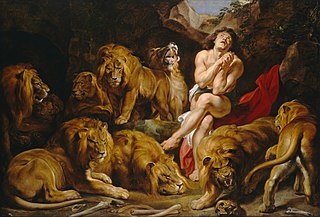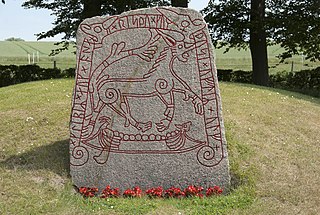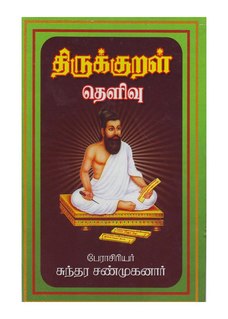Related Research Articles

The Book of Daniel is a 2nd-century BC biblical apocalypse with a 6th century BC setting. Ostensibly "an account of the activities and visions of Daniel, a noble Jew exiled at Babylon", it combines a prophecy of history with an eschatology both cosmic in scope and political in focus, and its message is that just as the God of Israel saves Daniel from his enemies, so he would save all Israel in their present oppression.

The Book of Isaiah is the first of the Latter Prophets in the Hebrew Bible and the first of the Major Prophets in the Christian Old Testament. It is identified by a superscription as the words of the 8th-century BCE prophet Isaiah ben Amoz, but there is extensive evidence that much of it was composed during the Babylonian captivity and later. Johann Christoph Döderlein suggested in 1775 that the book contained the works of two prophets separated by more than a century, and Bernhard Duhm originated the view, held as a consensus through most of the 20th century, that the book comprises three separate collections of oracles: Proto-Isaiah, containing the words of the 8th-century BCE prophet Isaiah; Deutero-Isaiah, the work of an anonymous 6th-century BCE author writing during the Exile; and Trito-Isaiah, composed after the return from Exile. Isaiah 1–33 promises judgment and restoration for Judah, Jerusalem and the nations, and chapters 34–66 presume that judgment has been pronounced and restoration follows soon. While virtually no scholars today attribute the entire book, or even most of it, to one person, the book's essential unity has become a focus in more recent research.
Chapter 11 of the United States Bankruptcy Code permits reorganization under the bankruptcy laws of the United States. Such reorganization, known as Chapter 11 bankruptcy, is available to every business, whether organized as a corporation, partnership or sole proprietorship, and to individuals, although it is most prominently used by corporate entities. In contrast, Chapter 7 governs the process of a liquidation bankruptcy, though liquidation may also occur under Chapter 11; while Chapter 13 provides a reorganization process for the majority of private individuals.

Deuteronomy is the fifth and last book of the Torah, where it is called Devarim and the fifth book of the Christian Old Testament.

Fenrir or Fenrisúlfr, also referred to as Hróðvitnir and Vánagandr, or Vanargand, is a wolf in Norse mythology. Fenrir, together with Hel and the World Serpent, is a child of Loki and giantess Angrboða. He is attested in the Poetic Edda, compiled in the 13th century from earlier traditional sources, and the Prose Edda and Heimskringla, written in the 13th century by Snorri Sturluson. In both the Poetic Edda and Prose Edda, Fenrir is the father of the wolves Sköll and Hati Hróðvitnisson, is a son of Loki and is foretold to kill the god Odin during the events of Ragnarök, but will in turn be killed by Odin's son Víðarr.

In Norse paganism, Freyj is a goddess associated with love, beauty, fertility, sex, war, gold, and seiðr. Freyja is the owner of the necklace Brísingamen, rides a chariot pulled by two cats, is accompanied by the boar Hildisvíni, and possesses a cloak of falcon feathers. By her husband Óðr, she is the mother of two daughters, Hnoss and Gersemi. Along with her twin brother Freyr, her father Njörðr, and her mother, she is a member of the Vanir. Stemming from Old Norse Freyja, modern forms of the name include Freya, Freyia, and Freja.

The Book of Genesis is the first book of the Hebrew Bible and the Christian Old Testament. Its Hebrew name is the same as its first word, Bereshit. Genesis is an account of the creation of the world, the early history of humanity, and of Israel's ancestors and the origins of the Jewish people.

The book of Leviticus is the third book of the Torah and of the Old Testament, also known as the Third Book of Moses. Scholars generally agree that it developed over a long period of time, reaching its' present form during the Persian Period, from 538–332 BC.

Mímir or Mim is a figure in Norse mythology, renowned for his knowledge and wisdom, who is beheaded during the Æsir–Vanir War. Afterward, the god Odin carries around Mímir's head and it recites secret knowledge and counsel to him.

Zhuang Zhou, commonly known as Zhuangzi, was an influential Chinese philosopher who lived around the 4th century BCE during the Warring States period, a period of great development in Chinese philosophy, the Hundred Schools of Thought. He is credited with writing—in part or in whole—a work known by his name, the Chuang Tzŭ, which is one of the foundational texts of Taoism.

A surah, is the equivalent of "chapter" in the Qur'an. There are 114 surahs in the Quran, each divided into ayats (verses). The chapters or surahs are of unequal length; the shortest surah (Al-Kawthar) has only three verses while the longest (Al-Baqara) contains 286 verses. Of the 114 chapters in the Quran, 86 are classified as Meccan, while 28 are Medinan. This classification is only approximate in regard to the location of revelation; any chapter revealed after migration of Muhammad to Medina (Hijrah) is termed Medinan and any revealed before that event is termed Meccan. The Meccan chapters generally deal with faith and scenes of the Hereafter while the Medinan chapters are more concerned with organizing the social life of the nascent Muslim community and leading Muslims to the goal of darul islam by showing strength towards the unbelievers. Except for surahAt-Tawbah, all chapters or surahs commence with "In the Name of Allah, Ar-Rahman, Ar-Rahim ". This formula is known as the Bismillah and denotes the boundaries between chapters. The chapters are arranged roughly in order of descending size; therefore the arrangement of the Quran is neither chronological nor thematic. Surahs (chapters) are recited during the standing portions (Qiyam) of Muslim prayers. SurahAl-Fatiha, the first chapter of the Quran, is recited in every unit of prayer and some units of prayer also involve recitation of all or part of any other surah.

The Nāṭya Śāstra is a Sanskrit treatise on the performing arts. The text is attributed to sage Bharata Muni, and its first complete compilation is dated to between 200 BCE and 200 CE, but estimates vary between 500 BCE and 500 CE.

The Bhagavata Purana, also known as the Srimad Bhagavatam, Srimad Bhagavata Mahapurana or simply Bhagavata, is one of Hinduism's eighteen great Puranas (Mahapuranas). Composed in Sanskrit by Veda Vyasa, it promotes bhakti (devotion) towards Krishna, integrating themes from the Advaita (monism) philosophy of Adi Shankara, the Vishishtadvaita of Ramanujacharya and the Dvaita (dualism) of Madhvacharya. It is widely available in almost all Indian languages.

The Garuda Purana is one of 18 Mahāpurāṇa texts in Hinduism. It is a part of Vaishnavism literature corpus, primarily centering around Hindu god Vishnu. Composed in Sanskrit and also available in various languages like Gujarati and English. The earliest version of the text may have been composed in the first millennium CE, but it was likely expanded and changed over a long period of time.

The Skanda Purana is the largest Mukyapurana, a genre of eighteen Hindu religious texts. The text contains over 81,000 verses, and is of Kaumara literature, titled after Skanda, a son of Shiva and Parvati, who is also known as Murugan. While the text is named after Skanda, he does not feature either more or less prominently in this text than in other Shiva-related Puranas. The text has been an important historical record and influence on the Hindu traditions related to the war-god Skanda.

The Brahmanda Purana is a Sanskrit text and one of the eighteen major Puranas, a genre of Hindu texts. It is listed as the eighteenth Maha-Purana in almost all the anthologies. The text is also referred in medieval Indian literature as the Vayaviya Purana or Vayaviya Brahmanda, and it may have been same as the Vayu Purana before these texts developed into two overlapping compositions.

The Hells Angels Motorcycle Club (HAMC) is a worldwide outlaw motorcycle club whose members typically ride Harley-Davidson motorcycles. In the United States and Canada, the Hells Angels are incorporated as the Hells Angels Motorcycle Corporation. Common nicknames for the club are the "H.A.", "Red & White", "HAMC", and "81". With a membership between 3,000 and 3,600 and 467 chapters in 59 countries, the HAMC is one of the largest motorcycle clubs in the world.

The Bhagavad Gita, often referred to as the Gita, is a 700-verse Hindu scripture that is part of the epic Mahabharata, dated to the second half of the first millennium BCE and is typical of the Hindu synthesis. It is considered to be one of the holy scriptures for Hinduism.

The Tirukkuṟaḷ, or shortly theKural, is a classic Tamil language text consisting of 1,330 short couplets, or kurals, of seven words each. The text is divided into three books with aphoristic teachings on virtue (aram), wealth (porul) and love (inbam), respectively. Considered one of the greatest works ever written on ethics and morality, it is known for its universality and secular nature. Its authorship is traditionally attributed to Valluvar, also known in full as Thiruvalluvar. The text has been dated variously from 300 BCE to 5th century CE. The traditional accounts describe it as the last work of the third Sangam, but linguistic analysis suggests a later date of 450 to 500 CE and that it was composed after the Sangam period.
References
- ↑ Savill, Sheila (1978). Pears Encyclopaedia of Myths and Legends: Chapter 7. Oceania and Australia. Chapter 8. The Americas. Pelham. ISBN 9780720710502.
- ↑ Burton, John W. (1981). Studia Instituti Anthropos. Verlag der Missionsdruckerei St. Gabriel. ISBN 9783921389416.